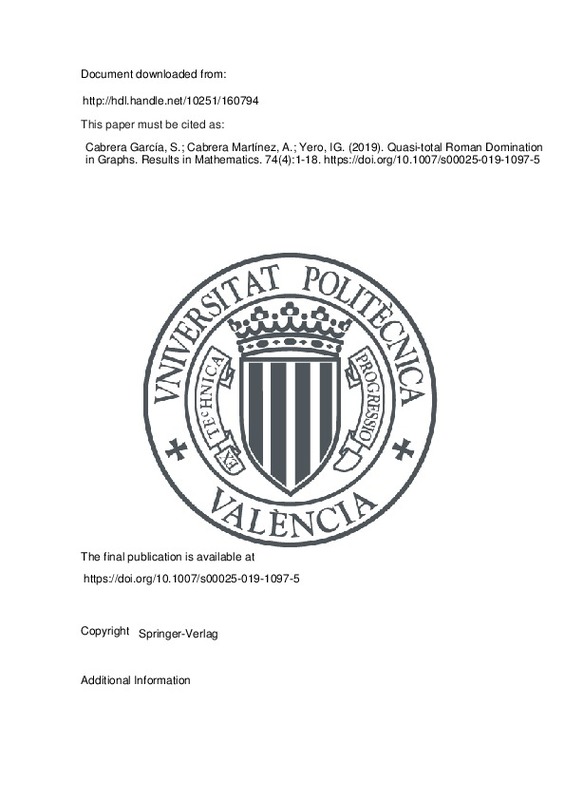JavaScript is disabled for your browser. Some features of this site may not work without it.
Buscar en RiuNet
Listar
Mi cuenta
Estadísticas
Ayuda RiuNet
Admin. UPV
Quasi-total Roman Domination in Graphs
Mostrar el registro sencillo del ítem
Ficheros en el ítem
| dc.contributor.author | Cabrera García, Suitberto
|
es_ES |
| dc.contributor.author | Cabrera Martínez, Abel
|
es_ES |
| dc.contributor.author | Yero, Ismael G.
|
es_ES |
| dc.date.accessioned | 2021-02-06T04:32:29Z | |
| dc.date.available | 2021-02-06T04:32:29Z | |
| dc.date.issued | 2019-12 | es_ES |
| dc.identifier.issn | 1422-6383 | es_ES |
| dc.identifier.uri | http://hdl.handle.net/10251/160794 | |
| dc.description.abstract | [EN] A quasi-total Roman dominating function on a graph G=(V,E) is a function f:V ->{0,1,2}satisfying the following: Every vertex for which u for which f(u) = 0 is adjacent to at least one vertex v for which f(v) = 2, and If x is an isolated vertex in the subgraph induced by the set of vertices labeled with 1 and 2, then f(x) = 1. The weight of a quasi-total Roman dominating function is the value omega(f) = f(V) = Sigma(u is an element of V) f(u). The minimum weight of a quasi-total Roman dominating function on a graph G is called the quasi-total Roman domination number of G. We introduce the quasi-total Roman domination number of graphs in this article, and begin the study of its combinatorial and computational properties. | es_ES |
| dc.language | Inglés | es_ES |
| dc.publisher | Springer-Verlag | es_ES |
| dc.relation.ispartof | Results in Mathematics | es_ES |
| dc.rights | Reserva de todos los derechos | es_ES |
| dc.subject | Quasi-total Roman domination number | es_ES |
| dc.subject | Roman domination number | es_ES |
| dc.subject | Total Roman domination number | es_ES |
| dc.subject.classification | ESTADISTICA E INVESTIGACION OPERATIVA | es_ES |
| dc.title | Quasi-total Roman Domination in Graphs | es_ES |
| dc.type | Artículo | es_ES |
| dc.identifier.doi | 10.1007/s00025-019-1097-5 | es_ES |
| dc.rights.accessRights | Abierto | es_ES |
| dc.contributor.affiliation | Universitat Politècnica de València. Departamento de Estadística e Investigación Operativa Aplicadas y Calidad - Departament d'Estadística i Investigació Operativa Aplicades i Qualitat | es_ES |
| dc.description.bibliographicCitation | Cabrera García, S.; Cabrera Martínez, A.; Yero, IG. (2019). Quasi-total Roman Domination in Graphs. Results in Mathematics. 74(4):1-18. https://doi.org/10.1007/s00025-019-1097-5 | es_ES |
| dc.description.accrualMethod | S | es_ES |
| dc.relation.publisherversion | https://doi.org/10.1007/s00025-019-1097-5 | es_ES |
| dc.description.upvformatpinicio | 1 | es_ES |
| dc.description.upvformatpfin | 18 | es_ES |
| dc.type.version | info:eu-repo/semantics/publishedVersion | es_ES |
| dc.description.volume | 74 | es_ES |
| dc.description.issue | 4 | es_ES |
| dc.relation.pasarela | S\398621 | es_ES |
| dc.description.references | Ahangar, H.Abdollahzadeh, Henning, M.A., Samodivkin, V., Yero, I.G.: Total Roman domination in graphs. Appl. Anal. Discrete Math. 10, 501–517 (2016) | es_ES |
| dc.description.references | Amjadi, J., Sheikholeslami, S.M., Soroudi, M.: Nordhaus–Gaddum bounds for total Roman domination. J. Comb. Optim. 35(1), 126–133 (2018) | es_ES |
| dc.description.references | Aouchiche, M., Hansen, P.: A survey of Nordhaus–Gaddum type relations. Discrete Appl. Math. 161, 466–546 (2013) | es_ES |
| dc.description.references | Chambers, E.W., Kinnersley, B., Prince, N., West, D.B.: Extremal problems for Roman domination. SIAM J. Discrete Math. 23(3), 1575–1586 (2009) | es_ES |
| dc.description.references | Chellali, M., Haynes, T., Hedetniemi, S.T.: Roman and total domination. Quaest. Math. 38, 749–757 (2015) | es_ES |
| dc.description.references | Cockayne, E.J., Dreyer, P.A., Hedetniemi, S.M., Hedetniemi, S.T.: Roman domination in graphs. Discrete Math. 278(1–3), 11–22 (2004) | es_ES |
| dc.description.references | Dreyer, P.A.: Applications and variations of domination in graphs. Ph.D. Thesis. New Brunswick, NJ (2000) | es_ES |
| dc.description.references | Haynes, T.W., Hedetniemi, S.T., Slater, P.J.: Domination in Graphs. Marcel Dekker Inc, New York, NY (1998) | es_ES |
| dc.description.references | Haynes, T.W., Hedetniemi, S.T., Slater, P.J.: Domination in Graphs: Advanced Topics. Marcel Dekker Inc, New York, NY (1998) | es_ES |
| dc.description.references | Henning, M.A.: A survey of selected recent results on total domination in graphs. Discrete Math. 309, 32–63 (2009) | es_ES |
| dc.description.references | Henning, M.A., Yeo, A.: Total Domination in Graphs. Springer Monographs in Mathematics. Springer-Verlag, New York (2013) | es_ES |
| dc.description.references | Liu, C.-H., Chang, G.J.: Roman domination on strongly chordal graphs. J. Combin. Optim. 26(3), 608–619 (2013) | es_ES |
| dc.description.references | Nordhaus, E.A., Gaddum, J.: On complementary graphs. Am. Math. Mon. 63, 175–177 (1956) | es_ES |
| dc.description.references | ReVelle, C.S.: Can you protect the Roman Empire? Johns Hopkins Mag. 49(2), 40 (1997) | es_ES |
| dc.description.references | ReVelle, C.S.: Test your solution to can you protect the Roman Empire? Johns Hopkins Mag. 49(3), 70 (1997) | es_ES |
| dc.description.references | ReVelle, C.S., Rosing, K.E.: Defendens Imperium Romanum: a classical problem in military. Am. Math. Month. 107(7), 585–594 (2000) | es_ES |
| dc.description.references | Stewart, I.: Defend the Roman Empire!. Sci. Am. 281(6), 136–139 (1999) | es_ES |
| dc.description.references | West, D.B.: Introduction to Graph Theory, 2nd edn. Prentice Hall, Upper Saddle River (2001) | es_ES |







![[Cerrado]](/themes/UPV/images/candado.png)

